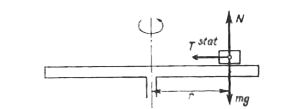A disk rotstes at 70 r.p.m. in a horizontal plane. How would you place an object on the disk so that it would remain on it? The coefficient of static friction between the object and the disk is μstat=0.44.
The correct Answer is:At a distance less than 8 cm from the centre of the disk.
In the case the object doesn.t slide off the disk, it will rotate with

the same angular speed as the disk. The centripetal acceleration is imparted to the object by the force of static friction (Fig.). We have
mω2r≤μstatmg, whence r≤μstatg/ω2
Similar Questions
An object of mass 10kg is to be kept at rest on an inclined plane making an angle of 37∘to the horizontal by applying a force F along the plane upwards as shown in figure . The coefficient of static fiction between the object and the plane is 0.2 Find the magnitude of force F
[Take g=10ms−2]

View SolutionTwo blocks of mass 'm' and 'M, are connect to the ends of a string passing over a pulley. 'M' lies on the plane inclined at an angle θ with the horizontal and 'm' is hanging vertically as shown in Fig. The coefficient of static friction between 'M' and the incline is μs. Find the minimum and maximum value of 'm' so that the system is at rest.

View Solution
Knowledge Check
You are to conduct a series of trials. For each trial the inclination of the plane is set to an angle theta, ranging from 0∘→90∘ and an object is released from rest at the top of the stationary inclined plane. The coefficient of static friction between the object and the inclined plane is mu_(s). In each case below, predict the observed outcome for the trial. In the following equation 'tumble' means 'tip' over and rotate' and 'sliding' means NO tumbling Case2 : The object is a cube and μs=0 In this experiment, the angle theta is varied only between 0^(@) and 45^(@)
 AThe cube will slide down for all 45∘>θ>0∘BThe cube will remain at rest for small theta and slide down only for theta greater then a certain non-zero valueCThe cube will roll without slipping for all 45∘>θ>0∘DThe cube will tumble down for all 45∘>θ>0∘
AThe cube will slide down for all 45∘>θ>0∘BThe cube will remain at rest for small theta and slide down only for theta greater then a certain non-zero valueCThe cube will roll without slipping for all 45∘>θ>0∘DThe cube will tumble down for all 45∘>θ>0∘You are to conduct a series of trials. For each trial the inclination of the plane is set to an angle theta, ranging from 0∘→90∘ and an object is released from rest at the top of the stationary inclined plane. The coefficient of static friction between the object and the inclined plane is μs. In each case below, predict the observed outcome for the trial. In the following equation 'tumble' means 'tip' over and rotate' and 'sliding' means NO tumbling Case3 : The object is a cube and mu_(s) is very large (μ>>1)
Athe cube will remain at rest for small theta and slide down only for theta greater than a certain non-zero valueBThe cube will stay on the incline as if it were glued to it, for all θCThe cube will move relative to the inclined plane only for θ=90∘DThe cube will tumble down only for θ>45∘You are to conduct a series of trials. For each trial the inclination of the plane is set to an angle theta, ranging from 0∘→90∘ and an object is released from rest at the top of the stationary inclined plane. The coefficient of static friction between the object and the inclined plane is μs. In each case below, predict the observed outcome for the trial. In the following equation 'tumble' means 'tip' over and rotate' and 'sliding' means NO tumbling Case1: The object is a sphere and μs=0
 AThe sphere will roll without slipping for small θ and slide down only for θ greater than a certain non-zero valueBThe sphere will remain at rest for small θ and roll without slipping only for θ greater than a certain non-zero valueCThe sphere will slide down for all θ>0∘DThe Sphere will roll without slipping for all θ>0∘
AThe sphere will roll without slipping for small θ and slide down only for θ greater than a certain non-zero valueBThe sphere will remain at rest for small θ and roll without slipping only for θ greater than a certain non-zero valueCThe sphere will slide down for all θ>0∘DThe Sphere will roll without slipping for all θ>0∘
A spring, placed horizontally on a rough surface is compressed by a block of mass m, placed on the same surface so as to store maximum energy in the spring. If the coefficient of friction between the block and the surface is μ, the potential energy stored in the spring is
View SolutionA block of mass m is pulled by a force of constant power P placed on a rough horizontal plane. The friction coefficient between the block and the surface is μ. Then
View SolutionA spring, placed horizontally on a rough surface is compressed by a block of mass m, placed on the same surface so as to store maximum energy in the spring. If the coefficient of friction between the block and the surface is μ, the potential energy stored in the spring is
View SolutionA block of mass m is pulled by a force of constant power P placed on a rough horizontal plane. The friction coefficient between the block and the surface is μ. Then
View SolutionA block of mass m is placed on a rough plane inclined at an angle θ with the horizontal. The coefficient of friction between the block and inclined plane is μ . Ifθ<tan−1(μ) , then net contact force exerted by the plane on the block is :
View Solution
